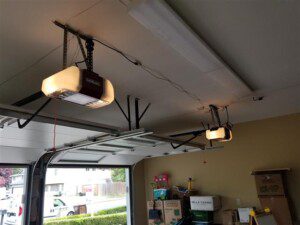
One component in a home that may be overlooked by some when considering safety is the automatic garage door opener. The convenience and ease of use of an automatic garage door opener makes our lives easier, and allows us to enter and exit a garage with the touch of a button. However, if proper safety mechanisms are not in place, the garage door and automatic garage door opener can pose a significant threat to the health and safety to home occupants, especially to small children.
In 1921 a man named C.G. Johnson invented the first overhead garage door. His invention was meant to save space and time by allowing users to open the door overhead, rather than have swinging doors that could be cumbersome and take up space. In 1926, C.G. Johnson invented the automatic garage door opener that utilized an electric motor to do the work of opening the overhead door. Although these inventions were revolutionary at the time, the equipment lacked safety features that are required today, which unfortunately lead to major injury and even death for some people.
In 1982, federal law mandated that all automatic garage door openers have a quick-release mechanism that allows a garage door to be disconnected from the automatic opener in the case of entrapment. In addition, automatic garage door openers were required to have an auto-reverse feature that allows the door to reverse if it strikes an object. In the early 90’s the requirement to have a redundant entrapment-prevention device installed was put into effect. This includes components such as a door edge sensor, or electric eye (motion sensor).
During a home inspection, an inspector will check for these safety components, and may test them to determine if they are in good working order. One common issue found is when the automatic safety function does not work. This function relies on the force of resistance to operate properly, and all automatic garage door openers will have a resistance sensitivity adjustment that tells the electric motor when to reverse. If the sensor is set too low, the door may reverse when force from normal use is exhibited, which makes it so that the door will not close. If the sensor is set too high, the door may not reverse when a reasonable force is applied. This makes the door dangerous, and entrapment is more likely.
Luckily, adjustment of an automatic reverse function for a garage door opener is easy, and most homeowners can accomplish this task on their own. Check out the video below on how to adjust the resistance settings on an automatic garage door opener.
*Please note that this video shows how to adjust controls on a specific automatic garage door brand, and may not accurately depict how to adjust controls on your particular opener. Always refer to the manufacturer’s operation instructions before attempting to adjust controls on your garage door opener. Failure to comply with specific manufacturer’s adjustment instructions could lead to improper function, injury or death.
